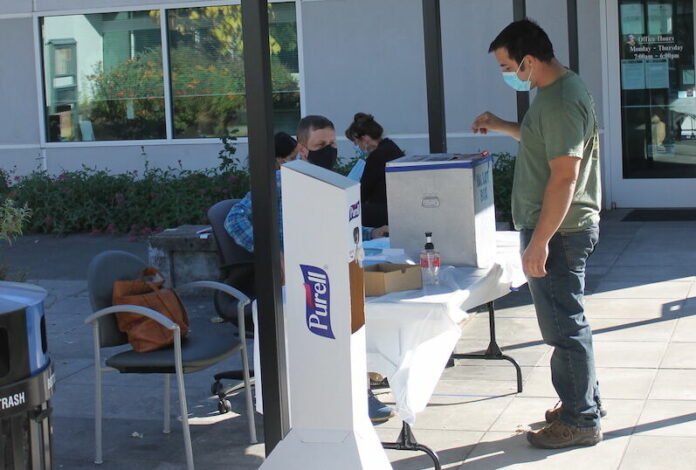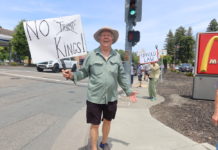In an eight-part series we look back at the world that was, here in our little corner of it. 2020 was a year of challenges. We’ll be publishing this eight-piece work daily as we work to the new year. Today’s piece is on elections that took place this year, and the challenges they presented.
As if there wasn’t enough going on in 2020, we also had not one but two elections.
The first, in March, was held alongside the presidential primary, and featured not only that national race, but state and local seats as well as a host of bond and tax measures.
While the school measures largely passed, two items of note that didn’t receive the required 65% of the vote was a measure to bolster fire prevention coffers locally and another to bolster the SMART train. North county supervisor James Gore wasn’t up for election, but three of his fellow supervisors were, and while voters returned Susan Gorin and Lynda Hopkins to office, Shirlee Zane was defeated by Chris Coursey.
A special election in May had only two items on it, neither of which impacted Windsor.
But the big news was the major election in November and a ballot filled with federal, state, county and town measures and candidates for voters to consider.
Windsor council race
For the first time, the town took part in district elections, directly electing an at-large mayor and electing a representative for district three. This year’s council race was more contentious than any council race in recent memory, with social media playing a strong, and particularly nasty, role in the election.
The primary targets of the vitriol were current council members Dominc Foppoli, who was running for the mayoral seat, and Debora Fudge, who was running for the District 3 seat. Despite that though, both candidates handily won their races.
At midnight on election night, with 85.71% of precincts reporting, Foppoli held a healthy lead in the mayoral race, with 4,837 (44.92%) votes. His closest challenger was Rosa Reynoza with 3,342 (31.04%) votes. Long-time council member Sam Salmon was third with 1,567 (14.55%) and newcomer Tanya Potter was fourth with 1,022 (9.49%). Fudge appeared to have won re-election with 1,397 (55.20%) of the votes over challenger Jeffrey Leasure with 1,134 votes (44.80%).
Earlier than anticipated, Sonoma County voting numbers were finalized on Nov. 23 and while the outcomes in Windsor didn’t changed, the numbers had shifted slightly.
In the final tally, Foppoli took the top spot in the mayoral race, with 6,307 (43.59%) votes. His closest challenger was Reynoza with 4,691 (32.42%) votes. Longtime council member Sam Salmon was third with 1,965 (13.58%) and newcomer Tanya Potter was fourth with 1,505 (10.40%).
In the first district town council race, longtime council member Debora Fudge won with 1,860 (53.87%) of the votes over challenger Jeffrey Leasure with 1,593 votes (46.13%).
Voter turnout for the county was a whopping 90.57%, with 272,244 of the 300,586 registered voters casting votes.
Local measures
Local ballot measures affecting Windsor voters, all also received the winning votes necessary to pass. Measure O, the mental health, addiction and homeless services measure won handily with yesses totaling 178,309 (68.07%) and nos at 83,659 (31.93%) and Measure P the changes to the IOLERO oversight of the sheriff’s department receiving 166,483 (64.74%) yes votes and 90,689 (35.26%) nos.
Measure BB approving the sale of Healdsburg District Hospital, which Windsor is in the district for, received 26,696 (84.49%) yesses and 4,900 (15.51%) nos.
Measure DD the extension of at transportation tax, is also looking to pass with 185,307 (70.95%) yesses and 75,878 (29.05%) nos.
Voting in a pandemic
One of the many systems altered by the COVID-19 pandemic was the voted in the general election on Nov. 3, which faced the dual challenge of the possibility of high turnouts while having to navigate pandemic-related social distancing and precautions.
While there were hundreds of partisan legal challenges elsewhere about what ballots should be counted, who’s eligible and when a vote is not a vote, there are no such potential ballot counting nightmares expected here, according to Registrar of Voters Deva Marie Proto.
“We’ve been doing vote-by-mail for many years and we now have 82% of our registered voters on our permanent mail voter lists,” said Proto.
The biggest change county voters saw was a relocation of most physical polling places. To meet COVID-19 pandemic safety measures, larger buildings had to be secured and no schools could be used due to related safety concerns.
All registered voters were mailed ballots on Oct. 5 and could begin voting right away by completing their ballots, adding a signature and returning them in the blue envelope with pre-paid postage.
Beginning Oct. 31, some 30 physical locations opened where voters could drop off completed ballots. These locations were open 9 a.m. to 5 p.m. from Oct. 31 to Nov. 2 and on Election Day, Nov. 3 from 7 a.m. to 8 p.m. On such location was the Windsor Town Hall.
There were also 20 locations with secured drop boxes for returning completed ballots, which will be available 24 hours a day, seven days a week, including one at the Bluebird Center in Windsor.
“We want everyone to vote safely and to vote early,” said Proto prior to the election.
Sonoma County completed a major paper-based voter system upgrade in 2017. All received ballots are scanned by computers with poll volunteers and registrar staff confirming all signatures by eye and hand-checking any ballots unable to be read by the computers. Proto said ballot “spoilage” has been very low in previous county elections.









